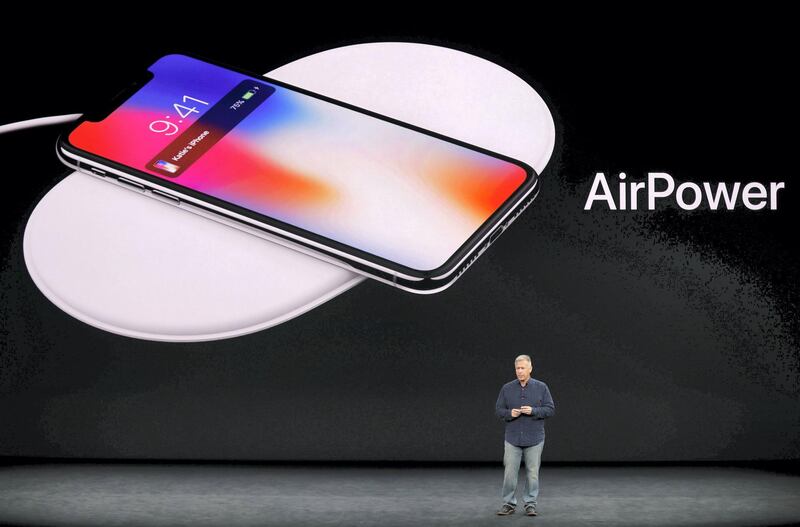Samsung last month launched a very amusing video as part of its rivalry with Apple, reliving the many innovations – including larger displays, extra internal memory and waterproofing - that came to its Galaxy range of smartphones ahead of the iPhone.
One of the latest of these “innovations” is the new wireless charging feature of the iPhone 8, 8 Plus and X models that have recently hit stores in the UAE.
Wireless charging is perhaps the most ancient of new features to be introduced by Apple in its latest smartphone range; the technology has been around on smartphones since at least 2009, appearing on the ahead-of-its-time but ill-fated Palm Pre. It subsequently re-appeared in 2012 on Nokia's Lumia range and Google's Nexus 4, before debuting with Samsung on the Galaxy S4 the following year.
It’s taken Apple until 2017 to be well and truly on board with the wireless charging, committing to the Wireless Power Consortium’s Qi standard, used by Samsung and others. So, in the unlikely event you’ve been charging your Galaxy S7 wirelessly and have crossed over to the other side, you’ll be able to use your old charger to boost your iPhone 8’s battery.
But given that it’s taken so long for Apple to introduce wireless charging for its smartphones, you can’t help wondering whether it’s really a priority for the company going forward, or indeed for the smartphone industry in general.
______________
Read more:
[ Time for smartphone makers to take a year off ]
[ Apple admits that interns worked illegal overtime on iPhone X ]
______________
This was borne out by a quick survey of my more gadget-savvy colleagues, who eagerly embraced wireless charging when it was first introduced by Samsung, only to go back to their wired chargers within months, frustrated at the general experience.
The accessories maker Belkin recently loaned me a Boost Up charger to experience wireless charging in conjunction with Apple’s iPhone X. After a couple of weeks, I’m more impressed with wireless charging than I once was. Hand on heart though, I can’t say it’s revolutionised my smartphone experience.
The charging area of the Boost Up (which retails for Dh249) is small and circular, a little smaller than a CD (that’s what we used to listen to music on, children), with a smaller silver ring in the middle. Once it’s plugged in, put your iPhone on it (you need to place it fairly centrally), and off you go.
The wireless charging experience was better than I had expected in two main ways; firstly, you can charge your phone wirelessly without having to remove it from its case, which will come as a relief to owners of the extremely shatterable iPhone 8 and iPhone X.
Secondly, charging was faster than I thought, with Apple promising further speed increases in due course. After letting my iPhone X run down to 3 per cent battery level, an hour worth of charging on the Boost Up bumped it up to a respectable 35 per cent after an hour’s charging. A standard USB wall plug and an old Lightning cable by contrast lifted a similarly depleted battery to just 22 per cent over the same time period.
Neither performance compares meaningfully to the iPhone’s fast charging capability, which saw battery life rise to 69 per cent over 60 minutes. But still, wireless charging isn’t as slow as some make it out to be.
That being said, the wireless charging experience needs some refinement to make it sufficiently convenient for mass adoption. I had to take extra care to ensure that my phone was correctly placed on the Boost Up to make sure it was actually charging; often I’d found it hadn’t charged at all because I’d put it on the charger in an incorrect position; there are a number of stories online about iPhones that move off the charger at night when they vibrate, a problem that never arises when you actually plug your phone into a physical charger. This problem may disappear as charging pads get bigger (Apple’s planning to introduce a charging pad that will charge three devices simultaneously in 2018), but for now it’s pretty irksome.
The bigger downside to Boost Up and the other horizontal wireless chargers is the limited functionality of your smartphone when it’s actually being charged compared with the wired alternative. If you think about it, there’s nothing to stop you using your smartphone to your heart’s content at your desk or in bed while it’s plugged into the wall.
Not so when your phone’s sitting on a wireless charger, meaning you have to peer over your phone and gingerly tap away at it while it’s charging.
There are a number of angled chargers out there - including the RavPower Quick Charge 2 and the Seneo Qi Wireless Charger - that allow for a better viewing experience. But there’s no getting around the fact that you can do far less with a smartphone that’s being charged wirelessly than with one that’s plugged into the wall.
In the end, my verdict on Belkin’s Boost Up - and wireless charging in general - in 2017 is much the same as my colleagues’ experiences from years ago. Being able to charge your phone without a cable is a nice idea in theory; in practice, however, it’s still not compelling or convenient enough to make me cut out the cables for good.






